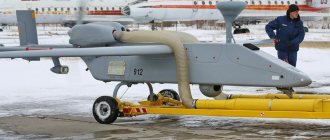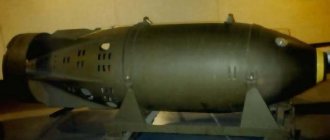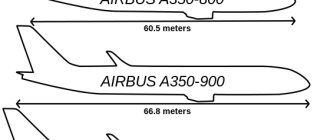| X-101 | |
| Kh-101 under the wing of Tu-95MSM | |
| General information | |
| A country | Russia |
| Purpose | Long range cruise missile |
| Developer | Design Bureau "Raduga" |
| Main characteristics | |
| Length (with MS) | 7.45 m [ source not specified 328 days ] |
| Diameter | 74 cm [ source not specified 328 days ] |
| Launch weight | ~ 2200–2400 kg [ source not specified 328 days ] |
| Throwing weight | ~ 400–430 kg [ source not specified 328 days ] |
| Maximum range | ~ 5500 km [ source not specified 328 days ] |
| Accuracy, CEP | 10 meters [ source not specified 328 days ] |
| Head type | regular (X-102 - special) [ source not specified 328 days ] |
| Number of warheads | 1[source not specified 328 days ] |
| Charge power | ? |
| Control system | ? |
| Launch history | |
| State | in service [ source not specified 328 days ] |
| Adopted | ? |
The X-101
(
X-102
version with a thermonuclear warhead), (pronounced "Ha-101") is a strategic air-to-ground cruise missile using radar stealth reduction technologies.[1][
unauthorized source?
] Developed by the Raduga design bureau (1995-2013).[
source not specified 328 days
]
Construction[ | ]
The engine is located inside the rocket. The missile is made on a new technological basis and has exclusively Russian components. Uses a combined guidance system: inertial system with optical-electronic correction; in the final section, a homing head is used [2]. Can receive complex information both along the route and target coordinates. Unlike previous generation missiles, there is a fundamental possibility of changing the target when the missile is already in flight[2].
The nuclear version (X-102) carries a warhead with a yield, according to various sources, of 250 kilotons[2] or 1 megaton[3].
According to test results, the missile has a circular probable deviation (CPD) of 7 m[4] at a range of 5500 km[5]. The missile is capable of destroying moving targets with an accuracy of up to 10 m.
Notes
- . MilitaryRussia.Ru - domestic military equipment (after 1945). Retrieved September 10, 2020.
- ↑ .
- : “Two drum launchers of the strategic missile carrier Tu-160 can accommodate 12 missiles.”
- : “The Russian Ministry of Defense published a video of missile strikes on the positions of Syrian militants by Tu-95MS strategic bombers. This is the first official evidence of the use of the new Kh-101 cruise missiles by the “bears” (as the planes were nicknamed by NATO). Before this, this weapon was used only by the Tu-160 strategic missile carriers.”
- : “The plane was specially modernized for new missiles: the pylons were strengthened, the on-board electronics were modified so that the plane could issue flight missions to missiles and perform other actions related to their combat use. The Tu-95MS can carry eight Kh-101s on pylons under the wings."
- : “It can carry eight cruise missiles. To do this, it was necessary to rework the pylons, modify the avionics so that the aircraft could issue flight missions to the missiles and carry out other actions related to the combat use of new cruise missiles.”
- . function.mil.ru. Retrieved November 19, 2020.
- . First channel. Retrieved November 21, 2020.
- .
- . RBC. Retrieved February 17, 2020.
Performance characteristics[ | ]
| Parameter | Meaning |
| Developer | MKB "Raduga" [ source not specified 328 days ] |
| Year the tests began | 1999[source not specified 328 days ] |
| Length, m | 7,45[source not specified 328 days ] |
| Diameter, mm | 742[source not specified 328 days ] |
| Wingspan, m | 3[source not specified 328 days ] |
| Starting weight, kg | 2200—2400[source not specified 328 days ] |
| Weight of warhead, kg | 400[2] |
| Fuel weight, kg | 1250[source not specified 328 days ] |
| Speed, m/s, cruising | 190—200[source not specified 328 days ] |
| Speed, m/s, maximum | 250—270[source not specified 328 days ] |
| Maximum range, km | 5500 km [ source not specified 328 days ] |
| Flight profile | changeable [ source not specified 328 days ] |
| Flight profile height, m | variable from 30-70 to 10,000 [ source not specified 328 days ] |
| EPR, m² | 0,01[source not specified 328 days ] |
| GOS type [ source not specified 328 days ] | optoelectronic correction system + TV (media) [source not specified 328 days ] ANN + laser altimeter/optical image based on standards of correction areas [ source not specified 328 days ] + (probably) at the final stage of flight - optical or radar seeker [ source not specified 328 days ] |
| Power point | Engine DTRD TRDD-50A with a thrust of 450 kgf [ source not specified 328 days ] |
| Accuracy (QUO), m | 10[source not specified 328 days ] |
| Nuclear version of the missile | X-102 with a thermonuclear charge with a power of 250 kt or 1 Mt [ source not specified 111 days ] |
| Carriers |
|
Our answer to the Tomahawks: what the X-101/X-102 ultra-long-range missile is capable of
News, Politics » Our answer to the Tomahawks: what the X-101/X-102 ultra-long-range missile is capable of
Russia has started serial production of electronic warfare (EW) equipment for the ultra-long-range air-launched cruise missile X-101/X-102. This was stated by Vladimir Mikheev, adviser to the first deputy general director of the Radioelectronic Technologies concern. According to him, the complexes must reliably protect the ammunition from the air defense systems of a potential enemy.
Currently, the defense industry of the Russian Federation is modernizing long-range aviation to use the X-101/X-102. What characteristics does the Russian rocket have - in the RT material.
Advisor to the First Deputy General Director of the Radio-Electronic Technologies Concern (KRET), Vladimir Mikheev, announced the launch of production of electronic warfare (EW) systems for the X-101/X-102 ultra-long-range air-to-ground cruise missile.
“Today our cruise missiles (X-101 and X-102 - editor’s note) have a full-fledged on-board defense complex, because such strategic weapons need to be very well protected,” Mikheev told RIA Novosti on the sidelines of the Airshow China 2020 air show taking place now in Zhuhai.
As military expert Yuri Knutov explained in a conversation with RT, electronic warfare equipment on cruise missiles is necessary to interfere with enemy radar stations. According to him, in previous years, Russian scientists have made great progress in the field of protecting aircraft and ammunition from the radars of Western states.
“The electronic warfare system on missiles is launched automatically after being irradiated by an enemy radar station. It actually blinds enemy air defense systems, making escort and destruction impossible. In simple terms, the target image disappears from the radar operator’s screen. Therefore, intercepting it is impossible,” Knutov said.
In his opinion, Russian industry continues to improve on-board electronic warfare systems. In the future, domestic cruise missiles will receive warheads that, when approaching a target, will create a powerful electromagnetic pulse. Thus, they will be able to disable all enemy electronics within a certain radius.
Range and accuracy
Kh-101/Kh-102 is a new air-launched cruise missile, which was created by specialists from the Raduga machine-building design bureau (Dubna) to replace the Soviet Kh-55 missiles. The development of ammunition started in the 1990s. The first tests of prototypes began in 1998, mass production began in 2002. However, the missile was not put into service until 2012.
The rocket is produced in two versions. X-101 is an ammunition with a conventional (high-explosive fragmentation) warhead with a capacity of about 400 kg in TNT equivalent. X-102 is a missile with a thermonuclear warhead with a yield of 250 kilotons to 1 megaton.
The length of the rocket is 7.45-7.6 m, weight - 2.2-2.4 tons, wingspan - 4.4 m, body diameter - 0.75 m, warhead weight - 400 kg. X-101/X-102 is launched at an altitude of up to 6 km, but the main part of the route flies at an altitude of 30–70 m, maneuvering and skirting the terrain.
The peculiarity of the missile is its stealth, which is achieved through a special aerodynamic design and the use of radio-absorbing materials. The effective dispersion area (ESR) of X-101/X-102 is estimated at 0.01 square meters. m (similar to stealth aircraft). According to Knutov, in combination with a modern electronic warfare system, optical and thermal protection, the Russian missile becomes practically invulnerable.
“It will be very difficult for radar systems to detect such a target. The most realistic way to intercept a missile is through visual detection by fighter jets specially adapted for this purpose. Theoretically, this is, of course, possible, but in practice it is an extremely time-consuming task,” Knutov noted.
The main advantages of the X-101/X-102 are its incredible range. In October 2020, Defense Minister Sergei Shoigu said that the missile can reliably hit targets at a distance of up to 4.5 thousand km. A number of domestic and Western media claim that the maximum range of the Russian missile is from 5 to 10 thousand km.
“The real tactical and technical characteristics of the X-101/X-102 are not disclosed. This is classified information. However, it is obvious that our missile is a strategic weapon that allows an aircraft to launch outside the enemy’s air defense coverage area,” Knutov said.
Another advantage of the rocket is its high accuracy. According to sources in the Izvestia newspaper, the X-101 with a conventional warhead can deviate from the target by less than 10 m with a launch range of up to 10 thousand km. According to the British analytical agency Jane's Information Group, the deviation of the X-101 does not exceed 20 m, and the X-102 - 100 m.
The Russian rocket is equipped with a small-sized turbofan engine (turbojet engine) with a thrust of about 360 kg. After launch, the power plant extends from the bottom of the fuselage. The maximum flight duration of the X-101/X-102 does not exceed ten hours, and the speed is 970 km/h.
The Russian missile is equipped with an inertial guidance system. During the flight, it uses an on-board digital computer with correction using digital maps and an optical-electronic altimeter (transmits an image of the terrain). In addition, the X-101/X-102 is “oriented” according to the coordinates of the Russian GLONASS navigation system. At the final stage, the missile is guided by an optical or radar correlation homing head (GOS).
“I coped with my tasks”
The X-101's baptism of fire took place on November 17, 2020 in Syria. The strikes on terrorist positions were carried out by Tu-95 MS strategic bombers (it was on these machines that missiles were tested in the 1990s and 2000s). The launches were carried out from the Mediterranean Sea. The X-101 was used in the SAR several times during 2020 and 2020 and mainly hit fortified militant command posts.
“Of course, there was no urgent military need for the use of the X-101, since it is a fairly expensive weapon. However, it was important for the Ministry of Defense to test our long-range aviation and the new missile in real combat conditions. The X-101 coped with its tasks perfectly, confirming the characteristics declared by the developer,” explained Knutov.
In November 2020, Chief of the General Staff of the Russian Armed Forces Valery Gerasimov announced that the modernization of long-range aviation aircraft of the Russian Aerospace Forces is being carried out “for the use of the new X-101 cruise missile.” The carriers of this ammunition are the strategic missile carriers Tu-95 MS and Tu-160. Some experts believe that in the future the Kh-101 will be armed with the Tu-22M3.
The Tu-95 MS is capable of carrying up to eight cruise missiles on an external sling, and the Tu-160 on revolving launchers (located inside the aircraft body) is capable of carrying up to 12. According to Knutov, the X-101/X-102 significantly enhance the combat capabilities of the air component of the nuclear triads of the Russian Federation.
“In my opinion, the X-101 far surpassed all foreign analogues. Its production was our response to the creation of the latest modification of the Tomahawk (Tomahawk Block IV). In the future, the X-101 will be included in the arsenal of a promising long-range bomber (PAK DA). And given the modernization potential of this high-precision weapon, we can safely say that the X-101 will serve our aviation for several decades,” concluded Knutov.
Combat use[ | ]
Kh-101 missiles were repeatedly used during the Russian military operation in Syria, which became their first combat use[10][11][12][13].
| date | Quantity | Carrier | Target |
| 17.11.2015[14] | 16 | Tu-160 | ISIS fighters in Syria |
| 19.11.2015 | 16 | Tu-160 | ISIS fighters in Syria |
| 20.11.2015 | 16 | Tu-160 | ISIS fighters in Syria |
| 17.11.2016 | ? | several Tu-95MSM | terrorist targets in the SAR |
| 5.07.2017[15] | 4 | Tu-95MS | ISIS fighters in Syria |
| 26.09.2017[16] | 4 | Tu-95MS | ISIS fighters in Syria |
New missiles for TU-160M2. It’s not even “Caliber” or “X-101”. Everything is much more serious
Do you remember how much noise there was after the Caliber salvo was fired at terrorists in Syria? Western experts rushed to prove that these were the wrong missiles, which were significantly worse than American ones. Because the Russians simply cannot make cruise missiles. The dispute did not have time to reach the upper boiling point and here is another Russian argument in favor of peace - the X-101 missile, which was very soon rated as “the smartest cruise missile.”
Since the “Caliber” and “Kh-101” began to visit terrorist bases quite regularly, the discussion in the Western media from the debate “whose rocket is better” smoothly moved to the topic “will the X-101 and “Caliber” reach Washington or not?
I want to make the debaters happy - by 2021, the Russian Army will be armed with the X-BD cruise missile, which will 100% reach anywhere in the world. Since this is a new product for the Russian defense industry, today one can only guess about the performance characteristics of the new product.
The most general information about the fundamentally new ultra-long-range cruise missile "X-BD" was shared by the head of the State Scientific Institute, Evgeny Fedorov.
Since the missile is ultra-long-range, its flight range will be significantly greater than that of the X-101 missile. And the “one hundred and first” flies, according to various estimates, 4,500 – 9,500 km. (range depends on the warhead). Since, as I understand it, “substantially more” is not 10–15 percent, but several times more, then we can talk about an intercontinental missile.
Here we need to take into account one more pattern: Americans traditionally overestimate the performance characteristics of their weapons, while representatives of the Russian defense industry underestimate them. In any case, there is no point in creating a new rocket and calling it ultra-long-range if it will fly only 500 kilometers further - even Russian patriots will laugh.
The next important characteristic of “X-BD” is not just intelligence, but full-scale intelligence. The TU-160M2 can launch a rocket literally from the Russian Central Non-Black Earth region overseas. The flight of the rocket can be adjusted at any point in the trajectory. But this is not the most important thing - the missile itself is capable of analyzing the missile defense system of a potential enemy and finding open windows in it. In fact, the target can be covered by the missile defense system or not – the result will be the same. In any case, for the next 20-30 years. And this is a very pessimistic forecast, since the United States is not currently even developing anti-missile systems that can intercept the X-BD missile.
Group use of missiles or “wolf pack” is also expected. This is no longer a new product, but a useful option when missiles exchange information with each other, redistribute targets by importance, find gaps in the missile defense system, etc.
I remember how five years ago in the Western press our strategic bombers were called exclusively flying rust buckets. Then they somehow forgot about the “buckets”... When Russia (this was two years ago) announced the creation of a new TU-160M bomber, even Russian experts called this statement propaganda.
But then Putin was in Kazan and was present at the exit from the factory workshops of the first production bomber.
Deputy Minister of Defense Yuri Borisov said that there is a state order for 50 new strategic bombers (Russia currently has 16). And all these “bombers” will carry 12 X-BD missiles on board. The result is a fairly formidable force - 600 ultra-long-range and high-precision missiles with a nuclear warhead.
However, the Ministry of Defense does not hide the main task that these “rust buckets” will perform - if necessary, on any continent and in the shortest possible time, to “thin out” NATO forces so that their further use, due to the decline in combat effectiveness, will be simple impossible.
Notes[ | ]
- X-101 / X-102 (Russian). MilitaryRussia.Ru - domestic military equipment (after 1945). Retrieved September 10, 2020.
- ↑ 1234
Valagin, 2020:1. - Anton Valagin
.
The X-101 cruise missile has been improved taking into account the Syrian experience, Rossiyskaya Gazeta
(January 24, 2018). Retrieved October 6, 2020. - The expert spoke about the accuracy of the Kh-101 cruise missiles used against militants in Syria.
- Kh-101/102, cruise missiles // Information Agency “Russian Arms”.
- Valagin, 2020: 1: “Two drum launchers of the strategic missile carrier Tu-160 can accommodate 12 missiles.”
- Valagin, 2020:2: “The Russian Ministry of Defense published a video of missile strikes on the positions of Syrian militants by Tu-95MS strategic bombers. This is the first official evidence of the use of the new Kh-101 cruise missiles by the “bears” (as the planes were nicknamed by NATO). Before this, this weapon was used only by the Tu-160 strategic missile carriers.”
- Valagin, 2020: 1: “The plane was specially modernized for new missiles: the pylons were strengthened, the on-board electronics were modified so that the plane could issue flight missions to missiles and perform other actions related to their combat use. The Tu-95MS can carry eight Kh-101s on pylons under the wings."
- Murakhovsky, 2020: “It can carry eight cruise missiles. To do this, it was necessary to rework the pylons, modify the avionics so that the aircraft could issue flight missions to the missiles and carry out other actions related to the combat use of new cruise missiles.”
- Ministry of Defense of the Russian Federation (unspecified)
. function.mil.ru. Retrieved November 19, 2020. - Vladimir Putin held a meeting with the leadership of the Ministry of Defense on the progress of the operation in Syria (unspecified)
. First channel. Retrieved November 21, 2020. - Gavrilov, 2020.
- Tu-95 bombers struck in the area of the “capital of ISIS” in Syria (unspecified)
. RBC. Retrieved February 17, 2020. - Tu-95MS bombers launched Kh-101 cruise missiles against ISIS object in Syria
. Russian Ministry of Defense. (July 5, 2017). - Tu-95MS fired Kh-101 cruise missiles at ISIS objects in SYRIA
. Russian Ministry of Defense. (September 26, 2017).
Sources[ | ]
- Anton Valagin.
In Russia they talked about the features of the X-101 missiles
(unspecified)
. Russian newspaper (November 18, 2016). - Anton Valagin.
Video: Tu-95 used new missiles for the first time in Syria
(unspecified)
. Russian newspaper (November 18, 2016). - Yuri Gavrilov.
Attack from the sea and two bases
(undefined)
. Russian newspaper (November 17, 2016). - Murakhovsky V.
The expert spoke about the accuracy of the Kh-101 cruise missiles
(unspecified)
. TASS (November 18, 2016).
The Russian Air Force will receive the Kh-101 cruise missile in 2013
At the beginning of 2013, a new cruise missile, the X-101, will be adopted by long-range aviation of the Russian Air Force, a source in the Russian Air Force told Izvestia. According to him, it is now undergoing flight tests. According to test firing data, the radius of deviation of the missile from the target does not exceed 10 m from 10 thousand km. At the same time, the Kh-101’s predecessor, the Kh-555 missile, has a deviation of 25–30 m. Thus, the Kh-101 will actually become the first high-precision non-nuclear missile in the arsenal of long-range aviation.
— The US Air Force adopted the first high-precision air-launched cruise missiles back in the 1980s. Until now, we have relied mainly on the destructive energy of a nuclear explosion, when plus or minus 50–100 m does not play a big role. Now the tasks have changed - you need to have high-precision weapons capable of brilliantly destroying an object,” a source in the main command of the Russian Air Force told Izvestia.
According to him, the presence of such a missile will allow long-range aviation to carry out high-precision strikes against both terrorist bases and strategic targets behind enemy lines, without risking the lives of pilots.
The Kh-101 is a long-range subsonic cruise missile. A navigation complex based on the GLONASS system guides the missile to the target. Unlike the X-555, the new missile will be able to destroy both small-sized (from 2-3 m) and moving objects, including a moving car, a representative of the military-industrial complex told Izvestia.
In case of radio-electronic interference and disconnection of satellite navigation systems, the missiles are equipped with autonomous inertial positioning systems.
Due to the new electronic base, the guidance system has become smaller than in Soviet missiles. The vacated space was taken by fuel and the warhead. If the X-555 flew 2 thousand km with a 200 kg warhead, then the X-101 already flew 10 thousand with a 400 kg warhead. There is also a nuclear version of the new missile, designated X-102.
— True, the X-101 still turned out to be about three to four times heavier than the X-555. Therefore, only the strategic missile carriers Tu-160 and Tu-95 can carry it. The Tu-22 bomber will not lift it. That’s why Backfire will remain with the old X-555 for now,” explained Izvestia’s interlocutor.
According to the President of the Institute for Strategic Assessments, Alexander Konovalov, long-range cruise missiles are now vital for the Russian Air Force.
— Due to Russia’s lack of military bases abroad, Russian fighters will not be able to cover bombers during transcontinental flights. Therefore, it is very important that the Tu-95 and Tu-160 are able to fire missiles without entering the enemy’s air defense coverage area,” Konovalov explained.
The closest analogue of the X-101 is the American long-range cruise missile AGM-129. It is also equipped with both a satellite navigation system (GPS) and an inertial one. The range of use of the American missile is just over 3 thousand km. The AGM-129 can only be launched from a B-52 heavy bomber.










